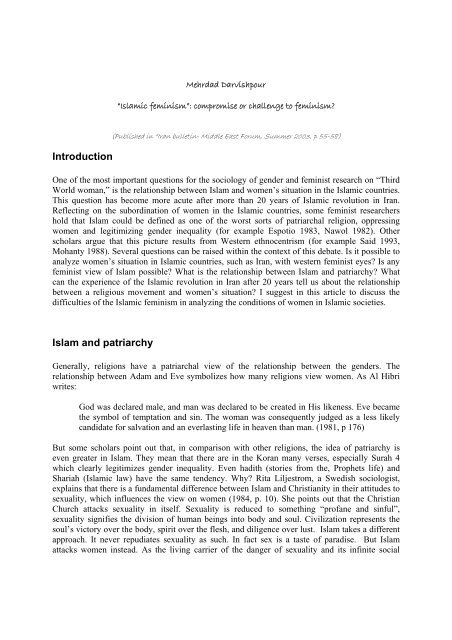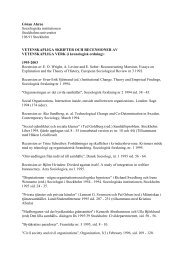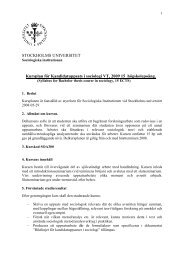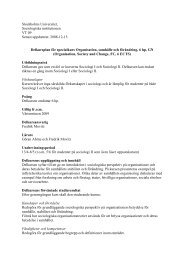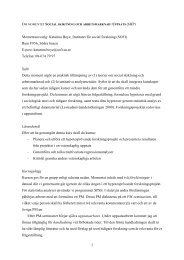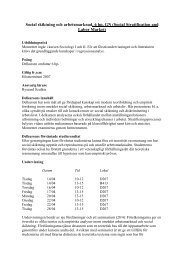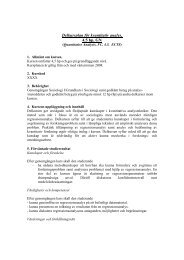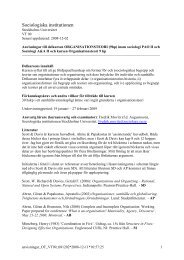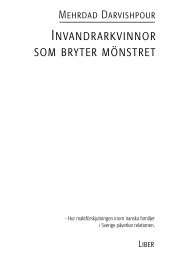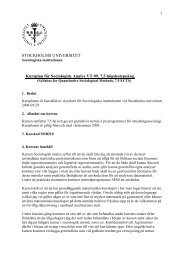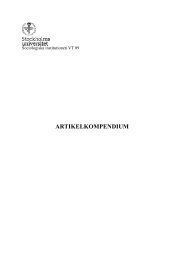Introduction Islam and patriarchy
Introduction Islam and patriarchy
Introduction Islam and patriarchy
You also want an ePaper? Increase the reach of your titles
YUMPU automatically turns print PDFs into web optimized ePapers that Google loves.
Mehrdad Darvishpour“<strong>Islam</strong>ic feminism”: compromise or challenge to feminism?<strong>Introduction</strong>(Published in “Iran bulletin- Middle East Forum, Summer 2003, p 55-58)One of the most important questions for the sociology of gender <strong>and</strong> feminist research on “ThirdWorld woman,” is the relationship between <strong>Islam</strong> <strong>and</strong> women’s situation in the <strong>Islam</strong>ic countries.This question has become more acute after more than 20 years of <strong>Islam</strong>ic revolution in Iran.Reflecting on the subordination of women in the <strong>Islam</strong>ic countries, some feminist researchershold that <strong>Islam</strong> could be defined as one of the worst sorts of patriarchal religion, oppressingwomen <strong>and</strong> legitimizing gender inequality (for example Espotio 1983, Nawol 1982). Otherscholars argue that this picture results from Western ethnocentrism (for example Said 1993,Mohanty 1988). Several questions can be raised within the context of this debate. Is it possible toanalyze women’s situation in <strong>Islam</strong>ic countries, such as Iran, with western feminist eyes? Is anyfeminist view of <strong>Islam</strong> possible? What is the relationship between <strong>Islam</strong> <strong>and</strong> <strong>patriarchy</strong>? Whatcan the experience of the <strong>Islam</strong>ic revolution in Iran after 20 years tell us about the relationshipbetween a religious movement <strong>and</strong> women’s situation? I suggest in this article to discuss thedifficulties of the <strong>Islam</strong>ic feminism in analyzing the conditions of women in <strong>Islam</strong>ic societies.<strong>Islam</strong> <strong>and</strong> <strong>patriarchy</strong>Generally, religions have a patriarchal view of the relationship between the genders. Therelationship between Adam <strong>and</strong> Eve symbolizes how many religions view women. As Al Hibriwrites:God was declared male, <strong>and</strong> man was declared to be created in His likeness. Eve becamethe symbol of temptation <strong>and</strong> sin. The woman was consequently judged as a less likelyc<strong>and</strong>idate for salvation <strong>and</strong> an everlasting life in heaven than man. (1981, p 176)But some scholars point out that, in comparison with other religions, the idea of <strong>patriarchy</strong> iseven greater in <strong>Islam</strong>. They mean that there are in the Koran many verses, especially Surah 4which clearly legitimizes gender inequality. Even hadith (stories from the, Prophets life) <strong>and</strong>Shariah (<strong>Islam</strong>ic law) have the same tendency. Why? Rita Liljestrom, a Swedish sociologist,explains that there is a fundamental difference between <strong>Islam</strong> <strong>and</strong> Christianity in their attitudes tosexuality, which influences the view on women (1984, p. 10). She points out that the ChristianChurch attacks sexuality in itself. Sexuality is reduced to something “profane <strong>and</strong> sinful”,sexuality signifies the division of human beings into body <strong>and</strong> soul. Civilization represents thesoul’s victory over the body, spirit over the flesh, <strong>and</strong> diligence over lust. <strong>Islam</strong> takes a differentapproach. It never repudiates sexuality as such. In fact sex is a taste of paradise. But <strong>Islam</strong>attacks women instead. As the living carrier of the danger of sexuality <strong>and</strong> its infinite social
destructive forces, women have to be controlled. Sexuality itself is not dangerous since it is theforetaste of paradise that leads men to Allah (Sabbah, 1984).The different views on the nature of sexuality have resulted in separate strategies ofcontrol within Christianity <strong>and</strong> <strong>Islam</strong>.Since <strong>Islam</strong> regards women as an active sexual power, it is important to restrict women’s sexualpower over men. The result is isolating women <strong>and</strong> men in different worlds. A woman’s sexualityhas to be concealed. Her looks <strong>and</strong> behavior must not reveal her sexual force since it will remindthe man of his weakness. Fatima Mernessi, a famous Arab feminist, explained a long time agothat the Christian portrayal of the individual as tragically torn between two poles (good <strong>and</strong> evil,flesh <strong>and</strong> spirit, instinct <strong>and</strong> reason) is very different from that of <strong>Islam</strong>, which has a moresophisticated theory of the instincts, more akin to the Freudian concept of the libido. She writes:In western culture, sexual inequality is based on the belief in the biological inferiority ofwoman. In <strong>Islam</strong>, it is the contrary: the whole system is based on the assumption thatwoman is a powerful <strong>and</strong> dangerous being. All sexual institutions (polygamy, repudiation,sexual segregation, etc.) can be perceived as a strategy for constraining her power(Mernissi 1975, P 16).This explains why the Koran maintains man’s superiority <strong>and</strong> domination over woman. It ismen’s responsibility <strong>and</strong> duty to keep women under their protection <strong>and</strong> control.The question is if every Muslim views gender relation with the same harshness as formulated in<strong>Islam</strong>. If not, could we infer that there is not necessarily any contradiction between believing in<strong>Islam</strong> <strong>and</strong> in gender equality? Muslim feminists point out that the picture of <strong>Islam</strong> as a hardpatriarchal religion is based on the dominating view of <strong>Islam</strong>, which is not necessary original<strong>Islam</strong>. They mean that this picture is the result of western imagination, of <strong>Islam</strong>’s attitude towomen, which is problematic (Afshar, 1998; Svensson, 1996).Western views of women in <strong>Islam</strong>ic countriesThe image of women in the “Third World” generally, <strong>and</strong> of Muslim women in particular, in theWest, is very schematic <strong>and</strong> prejudiced. Marred by racism <strong>and</strong> ethnocentrism, attitudes towardsMuslims have become harsher in recent years. The Muslim woman has been portrayed assubmissive, oppressed, <strong>and</strong> backward. Mass media <strong>and</strong> educational systems have played a majorrole in the construction of this representation. The popular book <strong>and</strong> movie Not Without MyDaughter is a good example which profoundly established this image by over-emphasizing thesignificance of veiling as a China-wall which separates Muslims from non-Muslims. Thisfabricated image ignores the connection between the oppression of women in the West <strong>and</strong> East.Not Without My Daughter reflects more a Western view of Muslim women than the realities ofwomen’s lives in <strong>Islam</strong>ic societies. It is this discourse which Edward Said (1993) calls“Orientalism.” In Orientalism, the Orient is created. The Orient is thus a linguistic, discursivecreation, rather than a place to which one can travel or in which one can live. The Orient ofOrientalism serves a dual function. It affirms the concept of the superiority of the West, <strong>and</strong>defines West’s normality by regulating the abnormal, forbidden, <strong>and</strong> dangerous to the Orient.
One addresses the practical aspects of Muslim’s everyday life in the primitive Arabian society.Other verses concern morality <strong>and</strong> are normative. Unlike the former group of verses whoseinterpretation must change to reflect the present conditions of any society, the latter do notdepend on time. But even in normative verses (especially in the surah “Women”) one can findpatriarchal ideas. Muslim feminists’ answer is that if you believe that Good is just <strong>and</strong> the Koranis God’s word, it is not reasonable to consider that any verse could legitimize gender inequality.They argue that the Koran introduces many powerful female figures who played important rolesin <strong>Islam</strong> <strong>and</strong> in the Prophet’s life, something that many of his successors did not favour(Svensson, 1996; Sajidzade, 1996). Muslim feminists point out that a liberal <strong>and</strong> feminist reviewof the Koran could contribute to the development of women’s emancipation in the <strong>Islam</strong>iccountry (Hassan, 1999).<strong>Islam</strong>ic feminism is clearly state feminism, or a part of fundamentalist <strong>and</strong> religiousmovement, <strong>and</strong> according to this trend, women’s identification with religious movements helpMuslim women’s emancipation. For example, Nesta Ramazani, an Iranian scholar (1993), pointsout that women’s gathering in religious mourning, their presence in Friday prayers, <strong>and</strong> theirparticipation in revolution <strong>and</strong> war eventually will lead to their emancipation. It is true that afterthe <strong>Islam</strong>ic revolution in Iran, women have been more active in political <strong>and</strong> social life. However,<strong>Islam</strong>ic women are usually active in officially sanctioned arenas such as religious rituals <strong>and</strong>campaigns in support of the regime. In fact, women st<strong>and</strong> to lose the most after revolution in theIran (Darvishpour, 1993).As an ideology, policy, <strong>and</strong> social movement feminism generally have been connected tosecularism. It is not surprising that many secular feminists found <strong>Islam</strong> to be a major opponentfor the feminist movement. For example, Shahrzad Mojab (1995) <strong>and</strong> Haiddeh Moghissi (1999),two Iranian feminists, belonging to the first type of feminist groups, argue that <strong>Islam</strong> is achallenge to feminism. Mojab argues that from an initial total rejection of <strong>Islam</strong>, feminism hasmoved towards a more sophisticated readjustment. She identifies five factors contributing to thisdevelopment in feminism. First, a sizable modern middle-class of women has formed in the urbancenters. The women are in professional occupations such as engineering, teaching, medicine,politics, business, etc. Second, women are elected as members of the parliament in at least a few<strong>Islam</strong>ic countries. Third, the increasing participation of women in the exp<strong>and</strong>ing capitalisteconomy has contributed to further awareness of the inequalities between genders, both at work<strong>and</strong> at home. Fourth, knowledge about feminism <strong>and</strong> struggles in other countries is transmittedwidely. Fifth, in many <strong>Islam</strong>ic countries, women’s organizations are active independent of thestate. Under these conditions, Muslim leaders <strong>and</strong> ideologists must meet the challenge of thefeminist movement. According to Mojab, <strong>Islam</strong>ic feminism is not a serious challenge against<strong>patriarchy</strong> <strong>and</strong> it is still far from independence, secularism, <strong>and</strong> democracy. The <strong>Islam</strong>ic feministmovement is more, a compromise with <strong>patriarchy</strong> than a realistic movement for the emancipationof women.A problem with Majab’s argument is that she never asks herself if any theoreticallyfeminist reinterpretation of <strong>Islam</strong> is possible. Another problem is that both <strong>Islam</strong>ic feminists <strong>and</strong>atheists feminist have only an ideological approach to religion. One argues that without believingin religion, women’s emancipation is impossible; the other proposes that it is only possible whenyou do not believe on religion. The question is, with these views, if any dialogue for womensolidarity <strong>and</strong> equality between these groups is possible.But Muslims feminists <strong>and</strong> secular feminists can have a dialogue about gender equality.Maybe it can be claimed that a liberal <strong>and</strong> milder interpretation of <strong>Islam</strong>, which tries to distanceitself from <strong>Islam</strong>’s misogynist rules <strong>and</strong> accepts gender equally, can improve the status of women
in <strong>Islam</strong>ic countries to a certain degree. But Question is to what degree a liberal review of <strong>Islam</strong>can improve women’s rights. Why do women’s rights have to be depending on any religiousviews? The experience of political <strong>Islam</strong> shows the difficulties of compromise between <strong>Islam</strong><strong>and</strong> feminism (Nawol, 1982, Hjärpe, 1983). The experience of the <strong>Islam</strong>ic revolution in Iranclearly shows the antifeminist <strong>and</strong> antidemocratic tendency of the fundamentalist <strong>and</strong> religiousmovement on which <strong>Islam</strong>ic feminism depends.The situation of Iranian women, Two decades after the <strong>Islam</strong>icrevolutionGenerally, women’s share of rights <strong>and</strong> resources has deteriorated since the revolution in 1979. Itis a result of the regressive policy of the <strong>Islam</strong>ic regime. Compulsory veiling, sex segregation,stoning women to death for adultery, were direct results of <strong>Islam</strong>ic government’s policy, whichstill continues, after more than 20 years. In particular, Iranian women suffer from the return totraditional laws of marriage <strong>and</strong> from reduced educational <strong>and</strong> occupational opportunities.Family LegislationAfter the Revolution, the family protection law i was reprieved <strong>and</strong> declared incompatible with thecanon of <strong>Islam</strong>ic laws. Consequently, the right to polygamous marriage was once again restored.The minimum age for women marriage fell from 18 to 13. The legal rights of women inapplication for divorce <strong>and</strong> custody of children were severely curtailed (Darvishpour 1993). Eventhough in recent years parts of the law have been revised, nothing has radically changed in thelaw. For example, Article 1043 of the civil law makes it clear that the marriage of a girl isdependent upon the consent of her father or gr<strong>and</strong>father. Articles 1117 <strong>and</strong> 54 declare thatmarried women can only accept jobs that are not incompatible with her responsibilities as a wife.Otherwise, she needs permission from her husb<strong>and</strong>. Article 1133, states that a man can divorce atany time he wishes, while a woman can request divorce only for “exceptional reasons.”Women <strong>and</strong> employmentUnder the <strong>Islam</strong>ic Republic the proportion of employed women has drastically declined. Within adecade, it fell from twelve percent in 1976 to six percent in 1986, resulting in hundreds ofthous<strong>and</strong>s unemployed women (Darvishpour 1993). While the <strong>Islam</strong>ic Republic of Iranintroduced measures to demobilize the more secularized Iranian women, it encouraged theparticipation of thous<strong>and</strong>s of religious women in the military, social, <strong>and</strong> political arenas. The“new” active women were mainly from the traditional middle-class who fought for the <strong>Islam</strong>icrepublic in the revolution. Although in recent years the percentage of employed women hasincreased from 6 in 1986 to 9 in1996, it is still less than women’s employment immediatelybefore the revolution.
Women <strong>and</strong> educationGenerally, after the <strong>Islam</strong>ic revolution education policy adapt to complete gender segregation inthe preliminary schools. More than 100 fields of studies, out of a total 431, at universities wereprohibited to women. The government’s justification was that, in accordance with the shari‘ah(<strong>Islam</strong>ic law), those courses were appropriate only for men. It is notable that this policy did notchange the proportion of female college students to their male classmates. When comparing 1977with 1987, the percentage of women is almost unchanged: about 30% of all students at theuniversity are women. Even if some courses were closed to women, percentage of femalestudents remained almost the same because they attended other courses (Darvishpour 1993). Butin recent year, after the initial bars on women’s study in some majors were lifted, the number offemale college students has increased. To day more than about 40% of all students at theuniversity are women, which is first of all result of women´s resistance (Darvishpour, 2001).Women’s ResistanceAs I pointed out earlier, women’s situation cannot be explained only as subordination. They havepower to act, too. Their resistance against discriminations in the educational system is a clearexample. Another instance of women’s resistance relates refusal to wear “the <strong>Islam</strong>ic veil,”despite probable punishments. In1993, 113,000 women were arrested in Iran for not complying tothe dress code.A third example is the new waves of the independent female magazines, books, <strong>and</strong> cinema.Despite all hindrances, great female writers, journalists, <strong>and</strong> film directors have called people’sattention to women´s questions. While the fundamentalist government tried to limit independentart, literature, films, <strong>and</strong> magazines, many women have been more active in those arenas thanunder Shah’s government.Examples above show just some aspects of women’s active resistance. Despite the factsthat a large group of Iranian intellectuals, middle class, <strong>and</strong> secular women were executed,imprisoned, or forced to run away from Iran, it is clear that women as an active group try todefend their rights.ConclusionThe question is whether women’s movements in <strong>Islam</strong>ic societies such as Iran have found theirway to challenge the establishment <strong>and</strong> to change the situation of women. Maybe not yet .Weneed more research on these questions. Perhaps it is not necessary for the feminist movement in<strong>Islam</strong>ic countries to declare war on religion. However, the experience of the <strong>Islam</strong>ic Republic ofIran shows how dangerous a religious movement could be for women. Secularism is anunavoidable prerequisite in women’s battle for liberation. Therefore, I insist that we shouldencourage secular feminism!Mehrdad DarvishpourDep of SociologyStockholm UniversityReferences
Afshar, Haleh. 1998. <strong>Islam</strong> <strong>and</strong> Feminisms, An Iranian Case-study. London: Macmilan PressLTD.Afshari, Reza. 1994. “Egalitarian <strong>Islam</strong> <strong>and</strong> Misogynist <strong>Islam</strong>ic Tradition: A Critique of theFeminist Reinterpretation of <strong>Islam</strong>ic History <strong>and</strong> Heritage”. Critique: Journal of Critical Studiesof Iran <strong>and</strong> the Middle East (4):13-33)Al-Hibri, Azizab. 1981. Capitalism is an Advanced Stage of Patriarchy. In Lydia Sargent (ed).Women <strong>and</strong> Revolution: A Discussion of the Unhappy Marriage of Marxism <strong>and</strong> Feminism.Boston: South End Press.Darvishpour, Mehrdad.1993. En bild av kvinnornas situation i Iran. Sociologisk forskning no. 3Darvishpour, Mehrdad. 2001. Chaleshgari zanan aleje nagh mardan (women chalenge the roll ofmen). Stockholm: Baranförlag.Espotio, John. 1982. Women in the Muslim Family. Syracuse: Syracuse University Press.Hassan, Riffat. 1999. “Feminism In <strong>Islam</strong>” In Sharma, Arvind & Young, Katherine k. (editor),Feminism <strong>and</strong> world Religion, State University of New York press, Albany.Hjärpe, Jan. 1983. Politisk islam. Studier i muslimsk fundamentalism. Göteborg: FörlagshusetGothia.Härpe, Jan. 1995. “<strong>Islam</strong>isk feminism”, Kvinnor och fundamentalism, nr 10, 1995.Liljeström, Rita. 1984. ”Skuggan av historiens mansvälde vilar tungt över sexualitet”.Inv<strong>and</strong>rare & Minoriteter, nr 5-6. SwedenMernessi, Fatima. 1975. Beyond the Veil. New York: John,Wiley <strong>and</strong> sonsMernessi, Fatima. 1993. Women <strong>and</strong> <strong>Islam</strong>, London: PRESSMohanty, Ch<strong>and</strong>ra. 1988. “Under Western Eyes”. Feminist Review 30Mojab, Shahrzad. 1995. <strong>Islam</strong>ic Feminism: Alternative or Contradiction. Fireweed, no. 47Nawol, Yasmina. 1982. Kvinnor under <strong>Islam</strong>. Stockholm: Röda rummetRamazani, Nesta. 1993. Women in Iran. Middle East Journal 43, no. 3Sabbah, Fatna A. 1984. Woman in the Muslim Unconscious. New York: Pergamon Press.Said, Edward. 1993 Orientalism. Stockholm: Ordfront.Sajidzade, Mohsen. 1996. ”Darbareje feminism va tatbigh an ba masael islami” (<strong>Islam</strong> <strong>and</strong>Fminism), Bonjad phajoheshhaj zanan. USA.Svensson, Jonas. 1996. Muslimsk feminism några exempel. Teologiska institutionen, LundsUniversitet.iIn 1967 <strong>and</strong> 1975, the first <strong>and</strong> second Family Protection laws were enacted. They ensured women the right todivorce, restricted polygamy, <strong>and</strong> prohibited pre-mature marriages. The laws changed the status for women. Civillaws, predating the <strong>Islam</strong>ic regime, restricted the discretionary power of men through the family protection law.Disputes concerning the undisputed rights of men in polygamous marriages, divorce, <strong>and</strong> custody of children weresettled through court rulings. For example, a dispute arising from the custody of children was given to the court. Theright to divorce was made conditional on the court ruling, <strong>and</strong> women obtained much more favorable terms <strong>and</strong>conditions for divorce. Having a second wife was made conditional on the consent of the first wife. Besides theinequality of treatment in civil rights, concerning adjudication, testimony, inheritance, employment, <strong>and</strong> education,the new civil laws extend inequality to the realm of marriage. They ensured women the right to divorce <strong>and</strong> restrictedpolygamy.


